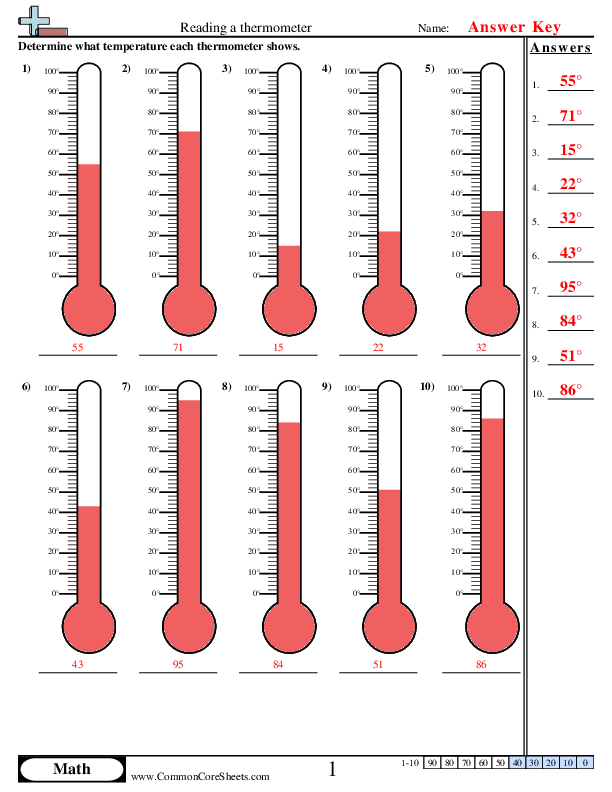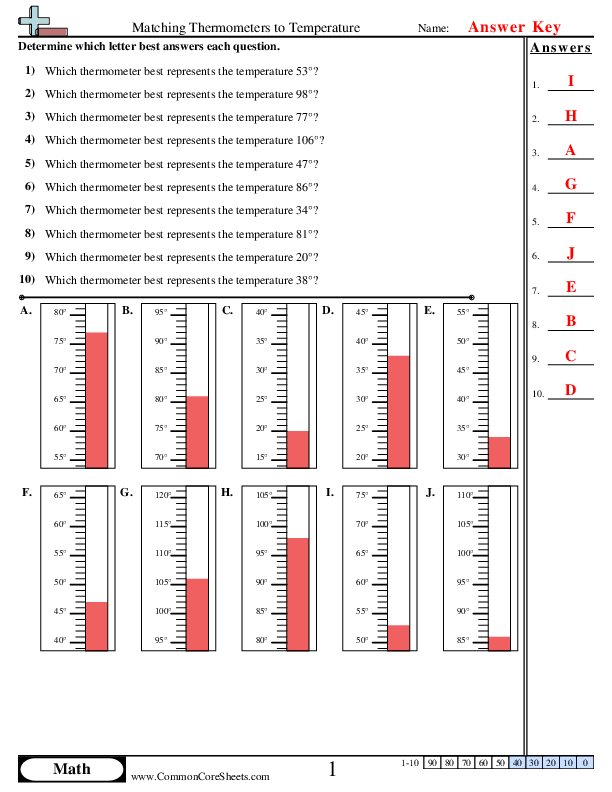Looking for the best temperature worksheets on the internet? Look no further! Our temperature worksheets are perfect for helping students learn about temperatures, thermometers and converting Fahrenheit. With our free temperature worksheets, you can be sure that your students gain a full understanding of temperature concepts before they move onto more difficult topics. Our worksheets feature images and diagrams of thermometers to help students visualize the concept of temperature while they practice using a variety of formulas. We also include detailed explanations and clear examples of how to use formulas in converting Fahrenheit to Celsius. We're sure our temperature worksheets will make learning about this topic easy for your students!
×

0° - 100° (10s labeled)


×
Description:
"This worksheet is designed to teach children about reading a thermometer through practical math problems. It includes 10 problems that provide real-world temperature readings between 0° and 100°. Each problem can be customized, converted into flashcards, or utilized in distance learning environments to make math fun and engaging while teaching critical weather-related concepts."

×
Student Goals:
Understanding of Basic ThermometryBy completing this worksheet, students should be able to gain a foundational understanding of how thermometers work. They will learn to interpret the scales and markings, understanding that these represent specific degrees of temperature. This understanding should extend to recognizing the demarcations and their implications, including the interpretation of the measurements represented by the thermometer.Grasp of Quantitative MeasurementQuantitative measurements are a critical part of many science and math concepts. Through this worksheet, students should learn to appreciate and understand the nature of numerical data and what measurements represent in real-world contexts. This understanding can form a basis for more complex scientific quantity-based concepts later on.Application of Practiced SkillsThe hands-on nature of this worksheet means students are not just learning about thermometer readings in the abstract, but actively practicing this skill. This repeated practice should enable them to become proficient in interpreting thermometer readings, a skill which can be applied in a variety of practical and academic contexts.Development of Observation SkillsStudents should demonstrate enhanced observational skills upon completion of the worksheet. Accurately reading a thermometer requires careful observation and attention to detail, both being critical skills applicable in a wide range of situations, both academic and real-world.Ability to Solve Temperature-Related ProblemsBeyond simply reading the thermometer, students should be able to apply the knowledge and skills gained to solve problems requiring temperature data. They should be able to extract temperature data based on thermometer readings and put this data into the correct context, whether it be a mathematical equation, a scientific experiment, or real-world scenario.



Matching Thermometers


×
Description:
"This worksheet is designed to help children learn temperature readings in a fun, interactive way. Through math-based exercises, such as matching a thermometer to the correct temperature, kids develop their understanding of weather and science concepts. This customizable worksheet, which can be converted into flashcards or used for distance learning, contains ten problems to ensure hands-on, practical learning opportunities in a digestible format."

×
Student Goals:
Understanding of Temperature MeasurementsUpon completion of the worksheet, students should have a deeper understanding of temperature measurements and how they correspond with various thermometer readings. They should be capable of accurately recognizing and interpreting the temperature on different types of thermometers, which is a fundamental skill in math as well as in everyday life situations.Enhancement of Problem-Solving AbilitiesThis exercise aims to improve the students' problem-solving abilities. Choosing the correct thermometer that represents a certain temperature requires careful analysis and critical thinking. By practicing this skill, they reinforce their ability to analyze a problem and identify the correct solution.Reinforce Math LearningsWhile the worksheet focuses on temperature reading, it indirectly includes numerical comprehension which is a pivotal element of mathematics. Students will be exposed to a range of numbers and must comprehend and compare these figures to find the appropriate match. This reinforces their overall mathematical abilities and understandings.Introduction to ThermodynamicsThis worksheet can potentially serve as a practical application and introduction to thermodynamics. The ability to recognize temperature can provide a basis for understanding the concepts of heat transfer and energy conversion in subsequent science subjects.Development of Precision and Attention to DetailSuccessfully completing this worksheet will illustrate the student's ability to pay attention to detail. Recognizing slight differences in temperature readings on the thermometers instills preciseness and careful observation. This builds an important character trait that is beneficial in broader study disciplines and life in general.Building Confidence in Individual AbilitiesThis worksheet is designed to increase student confidence in their individual abilities. Successfully identifying and matching thermometers to temperatures proves their capacity to understand complex concepts on their own. It heightens their self-confidence which can improve performance in other areas of their education.Demonstrating Knowledge ApplicationStudents will be able to demonstrate the application of their knowledge through this exercise. It's one thing to learn about temperature in a theoretical manner and another to apply what has been learned. Upon completion, the students should have proven they can successfully apply their knowledge of temperatures and thermometers to practical problems.



